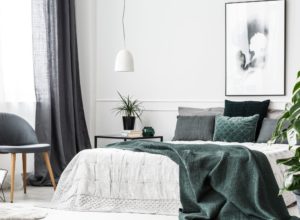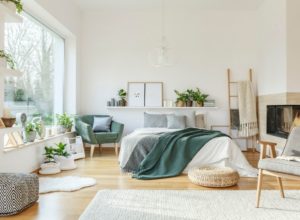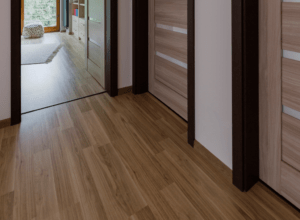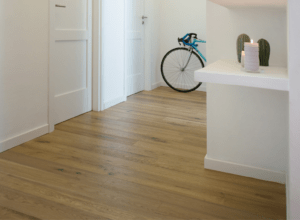

04 Aug How To Choose A Floor Colour – Design Guide
Looking to choose a flooring colour for your new home, or simply wanting to upgrade your interior design? This guide will provide all the answers you need when it comes to choosing the right floor colour when it comes to furniture, lighting and more!
The Importance of Floor Colour
Flooring is one of many crucial elements of your home design, considering it takes up the most space within your home. An ill-fitting colour can stick out like a sore thumb. It is imperative that the colour and style you choose not only looks great but is also a great complement for your home.
The colour you select will have a significant impact on your home’s overall look and feel. As such, consider what you want to achieve with your home, whether it is an open, inviting ambience or a sophisticated, cosy feel. Will you have multiple flooring colours throughout your home? These factors will greatly influence what is the best option for you.
An overall light colour palette can be creating a more optimistic happy, feel to your wood flooring . Shades such as golden yellow give your flooring a more fun, free feel, while cooler tones such as white and light beige provide an atmosphere that exudes openness and purity, which can be great for your living room. On the other hand, darker flooring colours, for example, brown and black can achieve a classy and luxurious feel, whilst also emanating a powerful and dramatic edge.


Unhappy with your Floor Colour?
If you feel like the colour of your flooring no longer matches the mood you want, or if it has dulled over time, you could consider a change. There are three main solutions to this; Staining, Replacing, or Laying over.
- Sanding & Staining – This option is only applicable to wooden timber floors. The process of a floor being stained involves sanding the planks back to bare wood before applying the stain. The floor can then be sealed with various types of lacquer or varnish, which locks in the colour while protecting the floors. However, be careful that not every flooring type is able to be stained.
- Replacement – If your flooring is also in a bad shape, for example, excess water exposure over the long term or accumulated scuff marks, it may be worth it to just replace your flooring entirely. This way, you are able to start from scratch, which gives full freedom over the types and colours you use to rejuvenate your home. However, this will be more expensive compared to the other options.
- Lay Floating Flooring – If you existing floor is quite flat, you can lay new floating floors directly over without needing to replace the old ones. They don’t require any glue or nails, which also make this DIY friendly!
Influence of Your Interior
There are many factors to consider in order to master the art of colour matching. It even leaves expert interior decorators and architects stumped. However, here are some basic tips that can help you make a choice you are happy with.


Room Size
Preferable colour tones will contrast depending on your room size. If your room is large and wide, warm and dark tones such as walnut or wenge tend to make a room that is large seem smaller, which makes them much cosier. On the other hand, if you have a lack of space in a small room, the right colour can make a room seem much larger. Lighter coloured floors such as beige or a light oak hue can give an impression of a more spacious home. Of course, you do not have to follow these preferences.
It is perfectly okay to put darker tones in a small room, these shades will still bring a feeling of cosiness regardless.
Wood Flooring Colour
If you are only replacing a section of your home, contrasting colours by using different flooring finishes can work very well to make the room appear aesthetic, especially for splitting up open-plan homes. On the other hand, using the same shade of flooring throughout your home can also create a beautiful aesthetic. The key is to avoid overloading the palette with too many shades or colours.
There are no hard and fast unwritten rules, it is just about what you like the most! FloorVenue also offers a range of flooring with vast varieties of different tones to choose from.
Furniture
It is also important to align your flooring colour with the context of your home. It depends heavily on which part of your home you want to emphasise. Choose the right colour to complement existing furnishings, which will have a positive impact on your overall home aesthetic. Are there expensive designer artworks displayed?
You may want to ensure your floor complements this masterpiece, rather than competing with them for the limelight. Too many statement pieces and finishes can end up looking messy and disorganised. You may choose to take in samples of your standout furniture pieces to compare and contrast against different flooring types. This can help your selection process as well as assisting you in avoiding colour clashes.
Natural Light
Much like paint colours, your flooring can give off the impression of changing colour as natural light evolves throughout the day. This is where samples will come in handy! When you take samples home, ensure you compare them at different times of the day to make sure that you are happy with all the possible variations. We deliver free flooring samples to your doorstep!
The amount of natural and artificial light in your home can also influence your choice. If your home is lacking in natural light, a light flooring colour can alleviate this to help brighten up your home. Alternatively, if your home has ample natural or artificial light, you can try to contrast with dark brown or black tones which cause a pleasing blend to appear.


Popular and Trendy Examples
- Norwegian pine: This flooring tone has whitish hues which provide a bright and contemporary feel for your home. A perfect light coloured choice for brightening up your rooms.
- Maple: This flooring’s breezy yellow and beige tones will give your home an a lighter coloured, optimistic and modern look. Perfect for a modern touch for your rooms, especially with higher grade timbers which exude less variations and features.
- Grey Tones: Floors that come in a grey tone usually give off a peaceful and chic ambience. They can also give classic furnishings a more contemporary look, and have become more popular during recent years.
- Hardwood Flooring: Australian timbers and other local hardwoods carry a strong, dark earthen or blonde colour which is very popular in Australia.
- Japan Black: Dark coloured wood flooring is not the most common, however its unique style permeates across time. Black brings a very classy experience into your room.
Conclusion – Which Floor?
The next steps would be to actually explore the options available to you. You can learn more about which floor functionally suits your situation the best through our Ultimate Guide to Choosing a Floor, or jump straight to browsing the options available:
- Solid Timber Flooring – Authentic wood cut straight from the tree, usually pre-finished in the factory. Solid timber is highly valued and can be sanded and polished to renew its look every few years.
- Engineered Flooring – These planks include a thin veneer of real timber fused to a plywood base for greater dimensional stability and a slightly lower price tag than solid timber.
- Laminate Flooring – Made from recycled wood, these planks have a printed imaging to replicate the look and feel of real timber floorboards. Extremely durable and cost effective, laminate floors have become very common over time.
- Hybrid Flooring – Hybrid floors are made of plastic composites in a rigid board which is very durable and 100% waterproof. These planks also print and emboss wood designs, and are very popular amongst home owners in recent years.
- Vinyl Flooring – Vinyl planks are also 100% waterproof and are made of polyvinyl chloride. These are less popular in homes, but more common in commercial settings.
- Bamboo Flooring – Strand-woven from giant grass, these floorboards offer a unique grain pattern which can definitely appeal to modern interior designs with a touch of nature. They are also three times more durable than hardwoods.


In the end, it is all up to you to choose the right colour surface for your rooms! There is not one definitive answer, you are able to experiment with many options which may all look great in your house and complement well with any existing decor. The important thing is just to know what is available to you, and that you would like your choice!




























